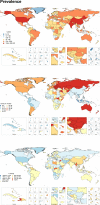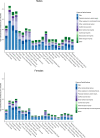Epidemiology of facial fractures: incidence, prevalence and years lived with disability estimates from the Global Burden of Disease 2017 study
- PMID: 31915268
- PMCID: PMC7571355
- DOI: 10.1136/injuryprev-2019-043297
Epidemiology of facial fractures: incidence, prevalence and years lived with disability estimates from the Global Burden of Disease 2017 study
Erratum in
-
Correction: Epidemiology of facial fractures: incidence, prevalence and years lived with disability estimates from the Global Burden of Disease 2017 study.Inj Prev. 2023 Feb;29(1):e1. doi: 10.1136/injuryprev-2019-043297corr1. Epub 2022 Dec 7. Inj Prev. 2023. PMID: 36600588 Free PMC article. No abstract available.
Abstract
Background: The Global Burden of Disease Study (GBD) has historically produced estimates of causes of injury such as falls but not the resulting types of injuries that occur. The objective of this study was to estimate the global incidence, prevalence and years lived with disability (YLDs) due to facial fractures and to estimate the leading injurious causes of facial fracture.
Methods: We obtained results from GBD 2017. First, the study estimated the incidence from each injury cause (eg, falls), and then the proportion of each cause that would result in facial fracture being the most disabling injury. Incidence, prevalence and YLDs of facial fractures are then calculated across causes.
Results: Globally, in 2017, there were 7 538 663 (95% uncertainty interval 6 116 489 to 9 493 113) new cases, 1 819 732 (1 609 419 to 2 091 618) prevalent cases, and 117 402 (73 266 to 169 689) YLDs due to facial fractures. In terms of age-standardised incidence, prevalence and YLDs, the global rates were 98 (80 to 123) per 100 000, 23 (20 to 27) per 100 000, and 2 (1 to 2) per 100 000, respectively. Facial fractures were most concentrated in Central Europe. Falls were the predominant cause in most regions.
Conclusions: Facial fractures are predominantly caused by falls and occur worldwide. Healthcare systems and public health agencies should investigate methods of all injury prevention. It is important for healthcare systems in every part of the world to ensure access to treatment resources.
Keywords: burden of disease; dental injury; descriptive epidemiology.
© Author(s) (or their employer(s)) 2020. Re-use permitted under CC BY. Published by BMJ.
Conflict of interest statement
Competing interests: SLJ works on a grant for influenza and respiratory syncytial disease that is funded by Sanofi Pasteur. This work does not relate to facial fracture burden.
Figures





References
Publication types
MeSH terms
LinkOut - more resources
Full Text Sources
Medical
